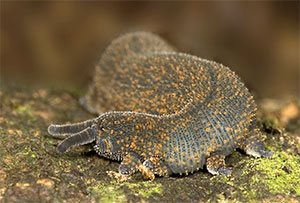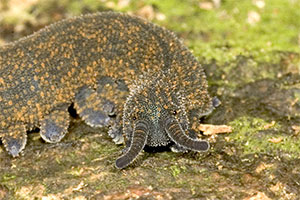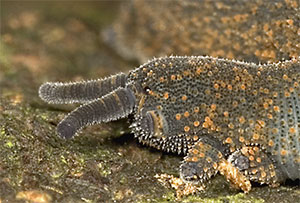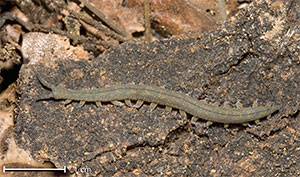|
Onychophora
 Peripatoides novaezealandiae
Peripatoides novaezealandiae, New Zealand.
with contribution by Prof. Hilke Ruhberg
Common name:
peripatus, velvet worm, Maori ngaokeoke.
Scientific name: phylum Onychophora Grube, 1853 — “claw bearers”.
Description
Onychophorans are better known as peripatus, or velvet worms. The New Zealand peripatus are secretive, caterpillar-like animals, with soft, unsegmented body, velvety in appearance. They are 2.0-8.0 cm in length, slow-moving, with 13-16 pairs of soft stumpy legs.
Peripatus are usually coloured in dull shades of blue, green, grey or brown. Several New Zealand species are more brightly coloured, for example, Peripatoides indigo from the Nelson region is indigo-blue. The head bears a pair of large antennae and a pair of small oral papillae. Two tiny dark beady eyes are located near the bases of antennae. The name “peripatus” is related to English “peripatetic” (travelling), and originates from Greek “peripatein” - “to walk around”, as these animals do with determination on their many stumpy legs.
 Peripatoides novaezealandiae
Peripatoides novaezealandiae looks at you with its
beady eyes.
|

Head of a peripatus ( Peripatoides novaezealandiae), close-up.
|
Velvet worms share a number of characteristics
with both phylum Annelida (segmented worms) and phylum Arthropoda. Some authors place onychophorans
in a subphylum within the phylum Arthropoda, but others (e.g.,
Nielsen 2001) regard the Onychophora as a separate phylum.
All species of peripatus described from New Zealand belong
to two genera - Peripatoides (live-bearing peripatus)
and Ooperipatellus (egg-laying peripatus).
Notes on biology
Peripatus are voracious predators and feed
on soil and litter arthropods (beetle larvae, crickets, spiders, termites, isopods, etc.), even on
animals larger than themselves. Peripatus hunts by stalking
the prey and immobilizing it with the transparent glue-like
substance, which is squirted from the openings beside the
mouth. This glue is extremely sticky, and soon entangles the
prey. Peripatus then approaches and bites the prey, injecting
it with digestive saliva; it can then suck out the liquified
body tissues. Velvet worms themselves can be preyed upon by
birds, lizards, large arthropods, and possibly rodents, although few
observations of predation exist.
Similar to insects, peripatus breathe atmospheric
air, which enters the body through spiracles - tiny openings
in the body cuticle. Unlike insects, however, velvet worms
cannot open or close the spiracles at will - the spiracles
are always open, making these animals extremely vulnerable
to dessication. The inability to control water loss restricts
peripatus to damp, humid habitats.
 Peripatoides novaezealandiae
Peripatoides novaezealandiae.
Peripatus grows throughout its life, shedding the thin outer cuticle every few weeks. The shed cuticle is immediately eaten by its owner to recycle the nutrients. The Peripatoides novaezealandiae pictured on this page, as all members of the genus Peripatoides, is ovoviviparous - the eggs are retained by female until they hatch internally, and live young are then born. Other New Zealand species (all Ooperipatellus) are egg-layers. There is no larval stage, and young peripatus resemble miniature, light-coloured adults. Baby peripatus can be seen sometimes in aggregation close to their mother, but it is believed that there is no parental care in peripatus.
Where to find them?
Peripatus are largely nocturnal and tend
to avoid light. They are not uncommon, but seldom very numerous.
They can be found in damp and secluded habitats — under
stones, in rotting wood, under the bark of fallen logs, in
leaf litter, most often in native forests, also in forest
remnants on farmland, in city parks, and sometimes in gardens.
Peripatus are best observed live in their environment, since
they are relatively rare and several species are protected.
After observing peripatus, make sure to place their home log
or stone back into place.
Distribution and conservation
The velvet worms living today are classified
into two families - the Peripatidae and the Peripatopsidae.
The Peripatidae are found in tropical regions of Central and
South America, South East Asia, and equatorial West Africa.
The Peripatopsidae are known from South Africa, Australia,
Tasmania, New Zealand, and Chile. All species found in New
Zealand belong to the family Peripatopsidae, five species
are known since 1980s, recently S. Trevick described 4 more,
and at least a few more are still undescribed. All ovoviviparous species (Peripatoides ssp.) are endemic to NZ, while the oviparous forms (Ooperipatellus ssp.) have close relatives in Australia (continent and Tasmania).
Peripatus are not uncommon in New Zealand,
but are rarely found in large numbers (although Prof. H. Ruhberg once found hundreds in a rotten log near Wellington (Moonshine Saddle), and A. Harris found thousands in a Dunedin garden). In many areas populations of peripatus are threatened by the destruction of microhabitats resulting from forest clearance, trampling by livestock, removal
of rotting logs for firewood, or fires. Overcollection is
also a significant threat. Ooperipatellus viridimaculatis
(Dendy, 1900) from the South Island (dark grey, with orange specks and a double row
of green spots along the back) is considered to be a threatened
species by the NZ Department of Conservation.
Included images:
- Family Peripatopsidae
- Peripatoides novaezealandiae - Ashurst Domain, WI, North Island (2 images)
- Peripatoides novaezealandiae - Palmerston North, WI, North Island (2 images)
- * - species exotic in NZ
Further information on New Zealand
peripatus:
Bathurst, M., Morris, R., Schneider, M.
2000. Velvet underground. New Zealand Geographic 46, p. 58-75.
Gleeson, D. M. 1996. Onychophora of New
Zealand; past, present and future. New Zealand Entomologist
19, p. 51-55.
Monge-Najera, J. 1995. Phylogeny, biogeography
and reproductive trends in the Onychophora. Zool. J. Linn.
Soc. 114, p. 21-60.
Reid, A.L. 1996. Review of the Peripatopsidae
(Onychophora) in Australia, with comments on peripatopsid
relationships. Invertebrate Taxonomy 10, p. 663-936.
Ruhberg, H. 1985. Die Peripatopsidae (Onychophora): Systematik, Ökologie, Chorologie und phylogenetische Aspekte.- In F. Schaller (ed): Zoologica 137: 1-183.
E. Schweitzerbart'sche Verlagsbuchhandlung, Stuttgart.
Trewick, S. A. 1998. Sympatric cryptic
species in New Zealand Onychophora. Biological Journal of
the Linnean Society 63, p. 307-329.
Onychophora Resources on the Web:
New Zealand Onychophora, maintained by the N.Z. Landcare Research. Includes information on biology of New Zealand peripatus, description of currently recognized species, and the location guide.
Onychophora:
The Velvet Worms, by Jean-Jacques Geoffroy, Centre International
de Myriapodologie. Includes general information on onychophorans,
bibliography, and the check-list of world fauna.
Onychophora
Homepage, by Mike Grieneisen, includes comprehensive bibliography
on Onychophora, the e-mail directory of onychophoran enthusiasts,
the link to Onychophora discussion group, and Web links.
Onychophora
Online, by Julian Monge-Nágera, includes general
information on Ohychophora, a photo gallery, a directory of
people interested in Onychophora worldwide, and eight editions
of Onychophora Newsletter.
Onychophora Website, by Dr. Georg Mayer. Includes general information, distribution and bibliography; richly illustrated.
|